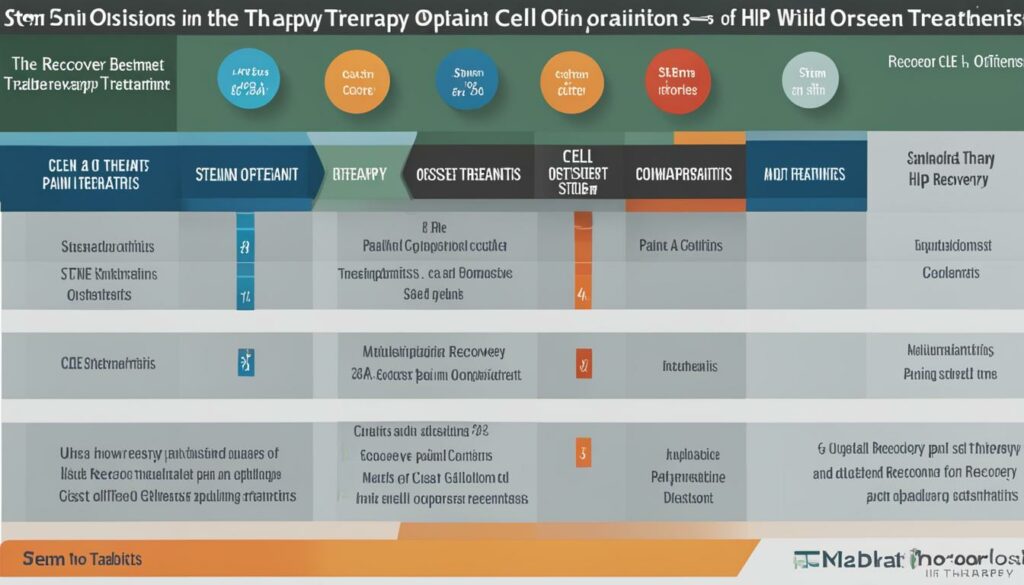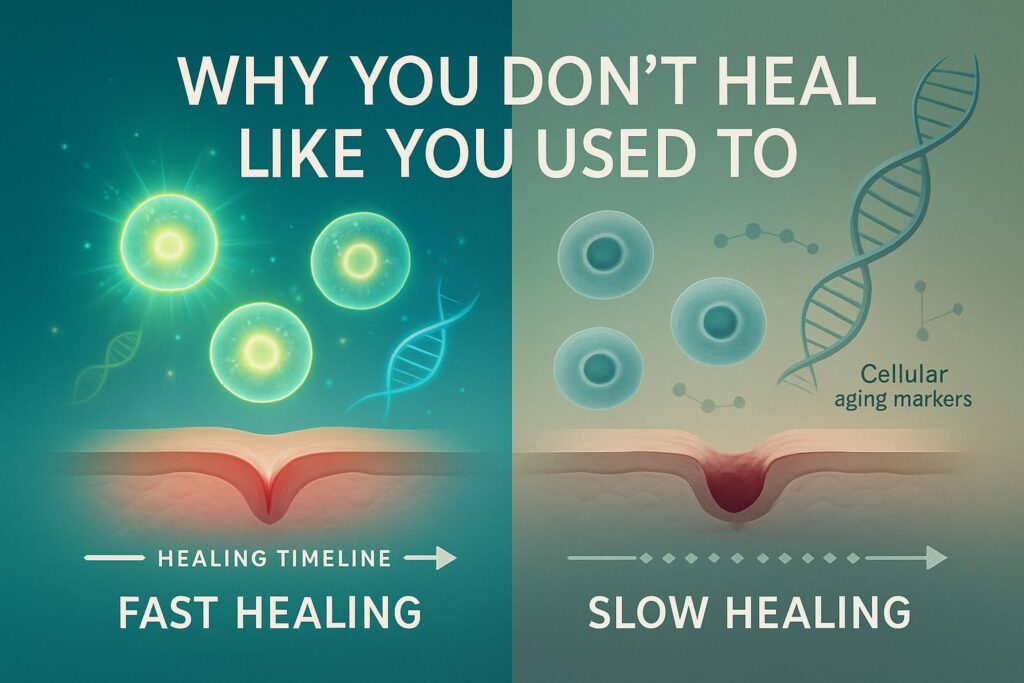Are you tired of living with the constant pain and limitations caused by hip osteoarthritis?
Are you searching for a treatment option that doesn’t involve surgery or medications?
Look no further – stem cell therapy may be the answer you’ve been seeking.
Hip osteoarthritis is a chronic condition that affects millions of people worldwide. It can significantly impact your quality of life, making simple tasks like walking or bending a painful ordeal. Traditional treatment options like hip replacement surgery or physical therapy may not always provide the desired results. But what if there was a regenerative treatment that could alleviate your pain and improve your joint function? That’s where stem cell therapy comes in.
Stem cell therapy for hip osteoarthritis utilizes the power of mesenchymal stem cells to regenerate damaged tissue and reduce inflammation in the hip joint. But does it really work? Can stem cell therapy provide long-term pain relief and improved joint function? Let’s delve into the details and find out how this innovative treatment option can potentially transform your life.
Key Takeaways:
- Stem cell therapy offers a non-surgical and medication-free approach to treating hip osteoarthritis.
- Mesenchymal stem cells have the ability to regenerate damaged tissue and reduce inflammation in the hip joint.
- Studies have shown positive outcomes and patient satisfaction with stem cell therapy for hip osteoarthritis.
- Compared to traditional treatment options, stem cell therapy focuses on the underlying cause of hip osteoarthritis and can provide long-term benefits.
- Stem cell therapy is a minimally invasive procedure with minimal risks, and post-treatment care and rehabilitation are essential for optimal results.
Understanding Hip Osteoarthritis
Hip osteoarthritis is a chronic condition that affects the hip joint, causing pain and stiffness. It occurs due to the degeneration of cartilage in the hip joint, leading to friction and inflammation. This degenerative process can significantly impact your ability to perform everyday activities, such as walking and bending. Common symptoms of hip osteoarthritis include joint pain, hip pain, and reduced range of motion.
Osteoarthritis of the hip can be caused by various factors, including aging, injury, or obesity. As cartilage deteriorates, the hip joint becomes less cushioned, leading to discomfort and difficulty moving. It is vital to seek treatment options that can alleviate pain and improve joint function.
Here are some key points to understand about hip osteoarthritis:
- Hip osteoarthritis is a chronic condition that causes pain and stiffness in the hip joint.
- The degeneration of cartilage in the hip joint leads to friction and inflammation.
- Common symptoms include joint pain, hip pain, and reduced range of motion.
- Hip osteoarthritis can occur due to aging, injury, or obesity.
- Treatment options are available to alleviate pain and improve joint function.
To visualize the hip joint and understand the impact of osteoarthritis, refer to the image below:
Benefits of Stem Cell Therapy for Hip Osteoarthritis
Stem cell therapy for hip osteoarthritis offers a range of important benefits. Firstly, it is a regenerative treatment that facilitates the repair and regeneration of damaged tissue in the hip joint, providing long-term pain relief and improved joint function. This therapy harnesses the power of mesenchymal stem cells, which have shown promising results in reducing inflammation and stimulating tissue regeneration.
Unlike invasive surgical procedures, stem cell therapy is minimally invasive and can be completed on an outpatient basis. This means you can avoid the risks and lengthy recovery periods associated with surgery while still benefiting from effective pain relief and improved joint function.
Here are some key benefits of stem cell therapy for hip osteoarthritis:
- Promotes tissue regeneration for long-term pain relief
- Improves joint function and mobility
- Reduces inflammation in the hip joint
- Avoids the need for invasive surgery
- Minimizes recovery time and hospitalization
In order to better understand the benefits of stem cell therapy, let’s take a closer look at how it works.
Regenerative Treatment for Long-Term Relief
One of the key advantages of stem cell therapy is its regenerative nature. By utilizing mesenchymal stem cells, this therapy promotes the natural repair and regeneration of damaged tissue in the hip joint. These stem cells have the capability to differentiate into various cell types, allowing them to replace damaged cells and stimulate the healing process.
Through this regenerative approach, stem cell therapy not only provides temporary pain relief but also addresses the underlying cause of hip osteoarthritis. By repairing and regenerating the damaged tissue, this treatment option offers the potential for long-term pain relief and improved joint function.
Reduced Inflammation and Improved Mobility
Inflammation is a common issue in hip osteoarthritis, leading to pain and limited mobility. Mesenchymal stem cells used in stem cell therapy have demonstrated the ability to reduce inflammation in the hip joint. By targeting and minimizing inflammation, this therapy can alleviate pain and improve mobility, allowing you to engage in daily activities with greater ease and comfort.
Avoidance of Invasive Surgery
Unlike invasive surgical procedures, such as hip replacement surgery, stem cell therapy for hip osteoarthritis is a non-surgical alternative. With stem cell therapy, there is no need for the removal of the entire hip joint. Instead, the therapy can be administered through minimally invasive injections directly into the affected area. This not only eliminates the risks associated with surgery but also reduces the recovery time and hospitalization required.
Minimally Invasive Outpatient Procedure
Stem cell therapy for hip osteoarthritis is a minimally invasive procedure that can be performed on an outpatient basis. This means you can receive the treatment without the need for an overnight stay in the hospital. The procedure typically involves the injection of mesenchymal stem cells into the hip joint, providing targeted relief and promoting tissue regeneration.
With the benefits of regenerative treatment, reduced inflammation, avoidance of invasive surgery, and a minimally invasive outpatient procedure, stem cell therapy offers a promising option for individuals seeking relief from hip osteoarthritis. In the next section, we will provide an overview of the stem cell therapy procedure.
Overview of Stem Cell Therapy Procedure
When it comes to treating hip osteoarthritis, stem cell therapy offers a regenerative treatment option that can provide relief from joint pain and improve hip function. This innovative procedure involves the injection of mesenchymal stem cells directly into the hip joint, targeting the underlying cause of the condition and promoting tissue repair and regeneration.
The injected mesenchymal stem cells have the remarkable ability to differentiate into various cell types, including cartilage and bone cells. This differentiation process can help repair the damaged tissues in the hip joint, reducing inflammation and stimulating the body’s natural healing process. By addressing the root cause of the pain and dysfunction, stem cell therapy offers a holistic approach to treating hip osteoarthritis.
One of the key advantages of stem cell therapy is that it is a minimally invasive procedure. It can be performed as an outpatient treatment, eliminating the need for hospitalization. This not only reduces the risk and complications associated with surgery but also allows for a quicker recovery and return to daily activities.
This treatment option is particularly beneficial for individuals experiencing joint pain and hip pain associated with hip osteoarthritis. The injected stem cells work to reduce inflammation, alleviate pain, and encourage the regeneration of healthy tissue in the hip joint. As a result, patients may experience long-term pain relief and improved joint function, enabling them to resume an active and pain-free lifestyle.
Efficacy and Research Findings of Stem Cell Therapy for Hip Osteoarthritis
Multiple studies and reviews have extensively examined the effectiveness of stem cell therapy for hip osteoarthritis. These investigations consistently demonstrate positive clinical outcomes, with patients experiencing notable pain relief and improved joint function following treatment. The regenerative properties of stem cell therapy play a crucial role in facilitating the repair and regeneration of damaged tissue in the hip joint, leading to long-term benefits for individuals with hip osteoarthritis.
Research findings have shed light on the immense potential of stem cell therapy as a viable treatment option for managing hip osteoarthritis. Clinical studies have documented the positive impact of stem cell therapy on pain reduction and improvement in joint function, providing hope for those seeking alternative, non-surgical solutions. The ability of stem cells to regenerate tissue contributes to the restoration of joint health and supports sustained relief from hip osteoarthritis symptoms.
These encouraging research outcomes underscore the efficacy of stem cell therapy in addressing hip osteoarthritis. By leveraging the regenerative power of stem cells, this innovative approach offers a promising avenue for individuals seeking effective management of their hip osteoarthritis symptoms.

| Treatment Effectiveness | Clinical Outcomes | Joint Function Improvement |
|---|---|---|
| Significant reduction in pain | Improved range of motion | Restored mobility |
| Enhanced quality of life | Decreased inflammation | Accelerated tissue repair |
| Long-term benefits | Positive patient satisfaction | Capacity for increased physical activity |
Comparison to Traditional Treatment Options
When it comes to managing hip osteoarthritis, there are various traditional treatment options available, including hip replacement surgery and physical therapy. However, stem cell therapy for hip osteoarthritis offers several significant advantages and can be a promising alternative.
One of the key benefits of stem cell therapy is that it provides a non-surgical approach to pain relief and improved joint function. While hip replacement surgery involves the complete removal of the damaged joint and the insertion of a prosthetic joint, stem cell therapy focuses on promoting tissue regeneration and repair. This regenerative property of stem cells addresses the underlying cause of hip osteoarthritis and can potentially offer long-term relief.
Additionally, stem cell therapy has a shorter recovery period compared to hip replacement surgery. After undergoing stem cell therapy, individuals can expect a relatively quicker return to their daily activities, as compared to the extensive rehabilitation required after surgery.
Physical therapy is another traditional treatment option for hip osteoarthritis. While physical therapy aims to improve joint function and reduce pain through exercises and stretches, stem cell therapy goes beyond temporary pain relief. Stem cells have the potential to stimulate the healing process, reduce inflammation, and regenerate damaged tissues in the hip joint.
The following table provides a comprehensive comparison between stem cell therapy, hip replacement surgery, and physical therapy for hip osteoarthritis:

It’s important to consult with a qualified healthcare professional to determine the most suitable treatment option for your specific condition. They can provide personalized recommendations based on the severity of your hip osteoarthritis, overall health, and individual goals.
Safety and Risks of Stem Cell Therapy for Hip Osteoarthritis
Stem cell therapy for hip osteoarthritis is a safe and minimally invasive procedure that utilizes autologous mesenchymal stem cells derived from your own body. This significantly reduces the risk of rejection or adverse reactions compared to other treatment options. The procedure does not require general anesthesia or hospitalization, making it a convenient choice for many individuals.
However, it is crucial to understand that like any medical procedure, there are potential risks involved. Although rare, there is a small chance of infection or bleeding at the injection site. It is important to note that these risks can be minimized by consulting with a qualified healthcare professional who specializes in stem cell therapy.
Benefits of Stem Cell Therapy: Safe and Regenerative
One of the major advantages of stem cell therapy for hip osteoarthritis is its regenerative nature. By promoting the repair and regeneration of damaged tissue in the hip joint, the therapy aims to alleviate pain and improve joint function in the long term. Compared to invasive surgeries or medications, stem cell therapy offers a safer and more natural approach to treating hip osteoarthritis.
It’s important to prioritize your safety and well-being when considering stem cell therapy for hip osteoarthritis. Consulting with a qualified healthcare professional who can assess your individual suitability for the procedure and guide you through the potential risks and benefits is crucial.
In the table below, we provide a summary of the safety and risks associated with stem cell therapy for hip osteoarthritis:
| Safety and Risks | Description |
|---|---|
| Minimal Risk of Rejection or Adverse Reactions | The use of autologous mesenchymal stem cells derived from your own body significantly reduces the risk of rejection or adverse reactions. |
| Minimally Invasive Procedure | Stem cell therapy for hip osteoarthritis does not require general anesthesia or hospitalization, minimizing the risks associated with invasive surgeries. |
| Potential Risks: | While rare, infection or bleeding at the injection site are possible risks associated with the procedure. Consulting with a qualified healthcare professional can help minimize these risks. |
It is essential to have a thorough understanding of the safety and risks involved in stem cell therapy for hip osteoarthritis. By making an informed decision and working closely with a healthcare professional, you can ensure a safe treatment journey and potentially experience the benefits of this innovative therapy.
Post-treatment Care and Rehabilitation
After undergoing stem cell therapy for hip osteoarthritis, proper post-treatment care and rehabilitation are crucial for a successful recovery. By following these guidelines, you can optimize the healing process and improve your chances of achieving long-term pain relief and restored joint function.
- Avoid Excessive Stress on the Treated Joint:
It is essential to give your treated joint time to heal and regenerate. For a few weeks after the procedure, try to avoid activities or movements that place excessive stress on your hip joint. This may include heavy lifting, high-impact exercises, or activities that require repetitive twisting or bending of the hip.
- Physical Therapy Exercises:
Physical therapy plays a vital role in your rehabilitation process. Your healthcare provider may recommend specific exercises to improve blood flow to the hip joint, promote tissue repair, and enhance joint function. These exercises can also help increase your range of motion, strengthen surrounding muscles, and improve overall hip stability.
- Supplements for Tissue Regeneration:
In addition to adhering to post-treatment care and physical therapy, your healthcare provider may suggest certain supplements to support healthy tissue regeneration. These supplements can provide essential nutrients and promote optimal healing of the hip joint. It is crucial to follow your healthcare provider’s recommendations and take supplements as directed.
By adopting these recommendations, you can maximize the benefits of stem cell therapy for hip osteoarthritis and accelerate your journey towards restored joint health and improved quality of life.
Patient Testimonials and Success Stories
Discover the real-life experiences of individuals who have undergone stem cell therapy for hip osteoarthritis. Their testimonials and success stories provide valuable insights into the effectiveness of this innovative treatment option in providing pain relief and improving joint function.
John’s Story: Overcoming Chronic Hip Pain
John, a 52-year-old avid hiker, had been suffering from chronic hip pain due to hip osteoarthritis for several years. His pain was so severe that it limited his ability to enjoy his favorite outdoor activities. Frustrated with traditional treatments that only provided temporary relief, John decided to explore stem cell therapy for his hip osteoarthritis. After undergoing the procedure, John experienced a significant reduction in pain and regained his mobility. He can now hike for miles without discomfort, thanks to the regenerative power of stem cell therapy.
Sarah’s Testimonial: A New Lease on Life
Sarah, a 67-year-old retiree, was struggling with daily activities due to hip osteoarthritis. Walking, climbing stairs, and even getting out of bed became painful and challenging tasks. Traditional treatments could only alleviate her pain temporarily, leaving her feeling frustrated and limited in her mobility. However, after undergoing stem cell therapy, Sarah’s hip pain diminished, and she regained her independence. Thanks to the regenerative properties of stem cells, Sarah now enjoys an active and pain-free retirement, engaging in activities that were once out of reach.
These are just a couple of examples of the success stories surrounding stem cell therapy for hip osteoarthritis. Many others have shared similar experiences of finding relief from pain and improving their joint function. Stem cell therapy has truly transformed the lives of individuals seeking an alternative to traditional treatments.
These patient testimonials serve as a testament to the effectiveness of stem cell therapy in alleviating hip osteoarthritis symptoms and improving overall quality of life. Their stories provide reassurance and confidence to those considering stem cell therapy as a viable treatment option for hip osteoarthritis.
| Patient | Pain Relief | Improved Joint Function |
|---|---|---|
| John | Significant reduction in pain | Regained mobility for hiking |
| Sarah | Diminished hip pain | Regained independence and active lifestyle |
| … | … | … |
Conclusion
Stem cell therapy for hip osteoarthritis is a promising regenerative treatment option that can provide much-needed relief from joint pain and improve your overall joint function. Unlike traditional treatment methods like hip replacement surgery or physical therapy, stem cell therapy offers a non-invasive approach that leverages the power of regenerating damaged tissue using mesenchymal stem cells. This innovative treatment targets the underlying cause of hip osteoarthritis, providing long-lasting results without the need for extensive recovery periods.
With an increasing number of positive clinical outcomes and patient testimonials, it is clear that stem cell therapy is becoming recognized as an effective and safe treatment for individuals with hip osteoarthritis. By promoting tissue repair and regeneration, this therapy not only offers pain relief but also helps to improve your joint function, allowing you to regain your mobility and enjoy a better quality of life. As a regenerative treatment, stem cell therapy addresses the root cause of your hip osteoarthritis, rather than simply masking the symptoms.
If you are struggling with joint pain and hip pain caused by osteoarthritis, consider exploring the benefits of stem cell therapy. Consult with a qualified healthcare professional to determine if this treatment option is suitable for you. Experience the potential of regenerative medicine and take the first step towards a pain-free and active life. Discover how stem cell therapy for hip osteoarthritis can bring relief and improve your joint function today.
FAQ
What is hip osteoarthritis?
Hip osteoarthritis is a chronic condition characterized by the degeneration of cartilage in the hip joint, leading to joint pain, stiffness, and reduced range of motion.
How does stem cell therapy for hip osteoarthritis work?
Stem cell therapy for hip osteoarthritis involves injecting mesenchymal stem cells into the hip joint, which can regenerate damaged tissue, reduce inflammation, and promote pain relief and improved joint function.
What are the benefits of stem cell therapy for hip osteoarthritis?
Stem cell therapy for hip osteoarthritis offers regenerative treatment, providing pain relief and improved joint function without the need for surgery or medications.
What is the procedure for stem cell therapy for hip osteoarthritis?
The procedure involves the injection of mesenchymal stem cells directly into the hip joint, promoting tissue repair and regeneration.
What are the research findings on the efficacy of stem cell therapy for hip osteoarthritis?
Numerous studies have shown positive clinical outcomes, with patients experiencing pain relief and improved joint function after receiving stem cell therapy for hip osteoarthritis.
How does stem cell therapy compare to traditional treatment options for hip osteoarthritis?
Stem cell therapy offers a non-surgical alternative that can effectively reduce pain and improve joint function, unlike traditional treatments such as hip replacement surgery or physical therapy.
Is stem cell therapy for hip osteoarthritis safe?
Yes, stem cell therapy for hip osteoarthritis is considered a safe procedure with minimal risks. The use of autologous mesenchymal stem cells reduces the risk of rejection or adverse reactions.
What is the post-treatment care and rehabilitation after stem cell therapy for hip osteoarthritis?
Post-treatment care may involve avoiding excessive stress on the treated joint and engaging in physical therapy exercises to improve blood flow and facilitate tissue repair and regeneration.
Are there any patient testimonials or success stories for stem cell therapy for hip osteoarthritis?
Many individuals who have undergone stem cell therapy for hip osteoarthritis have reported significant pain relief and improved joint function, sharing their positive experiences and outcomes.
What are the main conclusions regarding stem cell therapy for hip osteoarthritis?
Stem cell therapy for hip osteoarthritis is a promising regenerative treatment option that provides pain relief and improved joint function, offering an alternative to traditional treatment options.



